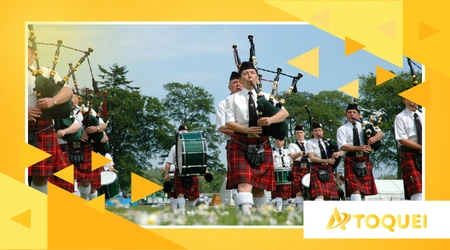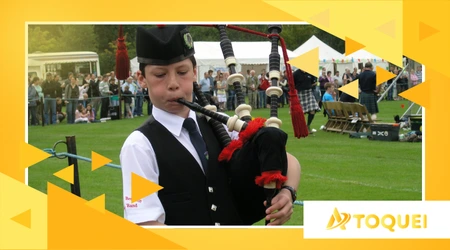Bagpipes: history, types and curiosities

THE Bagpipes is much more than a musical instrument; it is a cultural voice that echoes through the centuries.
Advertisements
Its unique and penetrating sound evokes ancient landscapes and vibrant celebrations.
Known globally, it carries with it an impressive historical legacy and fascinating typological diversity.
Let's dive into this universe of tradition and melody.
The history of bagpipes is as rich and complex as its melodies. It dates back to ancient times, with evidence of its existence in various civilizations.
Advertisements
It is not a Scottish invention, as many mistakenly believe.
Historical records place it in surprising places and remote times.
There is evidence of similar instruments already in Ancient Greece and in the Roman Empire.
The Greek term askaulos and the Roman tibia utricularis are direct precursors.
Emperor Nero, for example, was an enthusiast and player of a similar instrument.
Its spread throughout Europe and beyond occurred mainly with the Roman legionaries and migrations.
These journeys led her to adapt to local customs and materials.
This incredible ability to adapt ensures its survival and diversity to this day.
How did the Bagpipes Conquer Europe and the World?

The Middle Ages marked the height of the instrument's popularity on the continent. It ceased to be an instrument of the elite and became popular among the people.
Street performers, shepherds, and peasant festivals have embraced it fervently.
Its ease of transport and volume made it perfect for large celebrations.
Each region developed its own own variation in terms of construction and musical style.
Regional instruments flourished, creating a mosaic of sounds across Europe.
It was in the 15th century that its association with Scotland intensifies remarkably.
THE Great Highland Bagpipe became the icon that most people recognize today.
She played a crucial role in battles, inspiring courage in the Scottish troops.
++How to properly clean and maintain a clarinet
Its booming sound was ideal for communication in open, noisy fields.
THE bagpipes symbolizes Scottish resistance and cultural identity, becoming world famous.
What are the Main Types of Bagpipes?

The instrument's diversity is astonishing, encompassing hundreds of unique models.
++What is a dulcimer and where is it still used?
Each type has very distinct construction characteristics and timbres.
Why the Great Highland Bagpipe is the Most Famous?
This is undoubtedly the most iconic and powerful in terms of sound. It is the best-known and most widely played Scottish bagpipe worldwide.
It has a large bellows (the air bag), a pointer (chanter) and typically three catchphrases (the long tubes that produce fixed notes).
Explore more: Discovering Gamelan: Indonesia's Traditional Brass Orchestra
Its imposing sound is the result of high air pressure and robust double reeds.
What Makes the Uilleann Pipes Irish So Different?
THE Uilleann Pipes is notably smoother and more complex in its execution. Unlike the Scottish, it is elbow-operated instead of the mouth.
The player uses a bellows under his arm to inflate the bag, which allows him to sing or speak.
Its pointer has greater range and allows occlusions for greater melodic versatility.
++Medieval sounds in the City of Arts
She has catchphrases that can be turned on and off, and even regulators (side keys).
This complexity makes it ideal for chamber music or intricate soils.
What Other Examples of Regional Variations Are There?
There are countless examples demonstrating the adaptability of the instrument over time.
THE Galician Harmonica (Spain) and the Biniou (Brittany, France) are louder.
THE Zampogna (Italy) features an air pocket made from whole goatskin.
THE Dudelsack (Germany) and the Cabrette (Central France) have unique and regional characteristics.
This wide typological range ensures that the instrument can fit into any musical style.
What Curiosities and Relevant Data Mark the Bagpipes?
Few instruments carry so many peculiar stories and interesting facts.
Its simple yet ingenious structure always attracts the attention of musicians and engineers.
What is the Unusual Origin of Your Bellows (Bag)?
Originally, the bellows were made of stomach or whole skin of an animalThis primitive characteristic explains the durability and sound volume.
Today, goat skins, sheep skins or synthetic materials are commonly used.
THE Bagpipes and the Record for Largest Set:
At a landmark event in 2018 in Scotland, a record set of Great Highland Bagpipes played simultaneously. The event brought together 10,500 musicians at the Glasgow Sports Ground. This highlights the passion and unifying power that the instrument brings.
Think about bagpipes as a compressed air engine for music.
The bellows store the energy (the air), allowing the player to maintain a continuous and stable sound, “feeding” the reeds (the carburetors) with constant pressure, even while breathing.
It is a continuous sound machine, where the musician’s breathing recharges the “fuel”.
A Fact About Global Presence
Its cultural relevance and global presence are indisputable.
A 2023 survey indicated that there are over 200,000 active players of Great Highland Bagpipe throughout the world. This demonstrates its transcendence of the Scottish borders.
| Harmonica Type | Main Source | Air Mechanism | Characteristic Timbre |
| Great Highland Bagpipe | Scotland | Mouth | Strong, Penetrating |
| Uilleann Pipes | Ireland | Elbow (Mechanical Bellows) | Soft, Expressive |
| Galician Harmonica | Galicia (Spain) | Mouth | Bright, Sharp |
| Zampogna | Southern Italy | Mouth | Rustic, Deep |
THE Bagpipes and Its Impact on Contemporary Music
Far from being just a historical relic, the instrument continually reinvents itself. Rock, electronic music, and pop bands incorporate it into their arrangements.
This fusion creates new textures and attracts a younger audience.
For example, bands like AC/DC and the group Korn have already used the instrument in their compositions. The combination of riff of guitar and drone constant is powerful.
Another example is the musician Carlos Núñez, which takes the Galician tradition to World Music with mastery.
Conclusion: Why Do Bagpipes Remain So Relevant?
THE Bagpipes has stood the test of time, adapting and persisting for millennia. It is a musical testament to human resilience and innovation.
Her unique voice, ranging from epic to intimate, continues to move us. In an increasingly digital world, she connects us to our deepest roots.
Its vibrant melody reminds us of the richness of cultural traditions.
What more do we need to recognize the universality of this legendary instrument?
Frequently Asked Questions
Where can I learn to play the bagpipes?
There are several specialized schools and harmonica bands in large cities around the world, offering in-person and in-person lessons. online.
Are bagpipes difficult to play?
Mastering the instrument requires practice and coordination, especially to maintain constant air pressure while playing the melody.
What is the most important part of the bagpipes?
While all are crucial, the pointer (chanter), where the melody is played, and the reeds, which generate sound, are essential to music.
What is the average price of a good bagpipe?
Prices vary greatly depending on the type and material. Great Highland Bagpipe intermediate level can cost from R$ 5,000 to R$ 15,000, or more.
